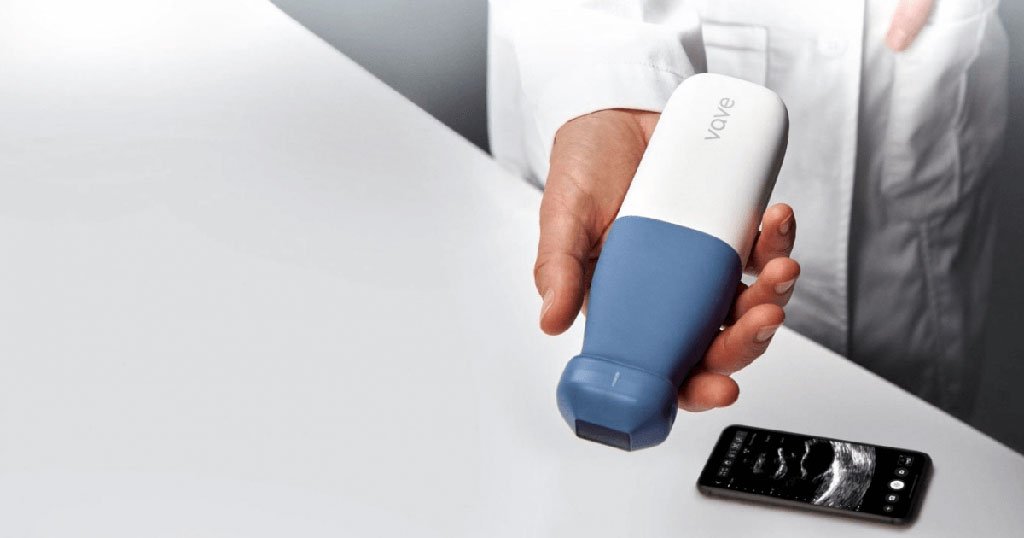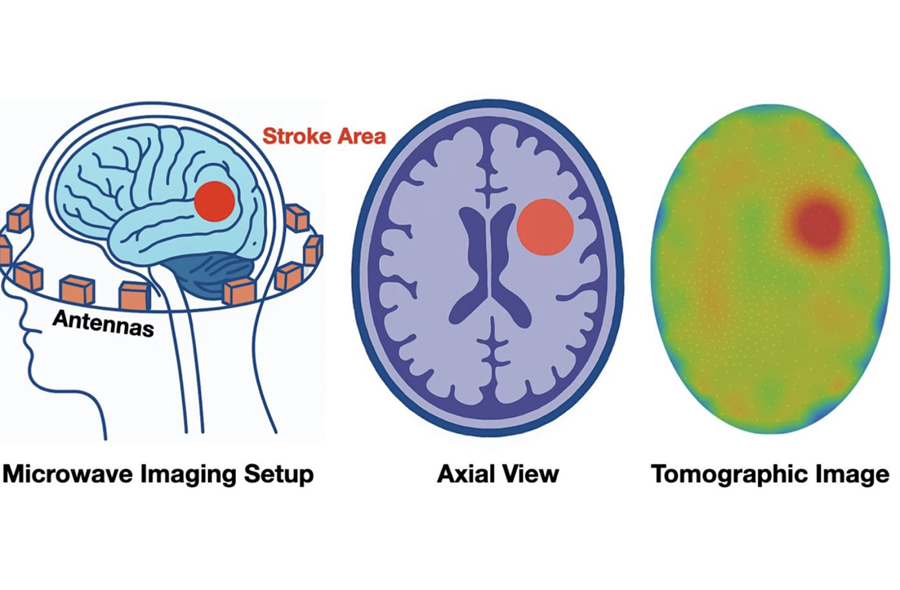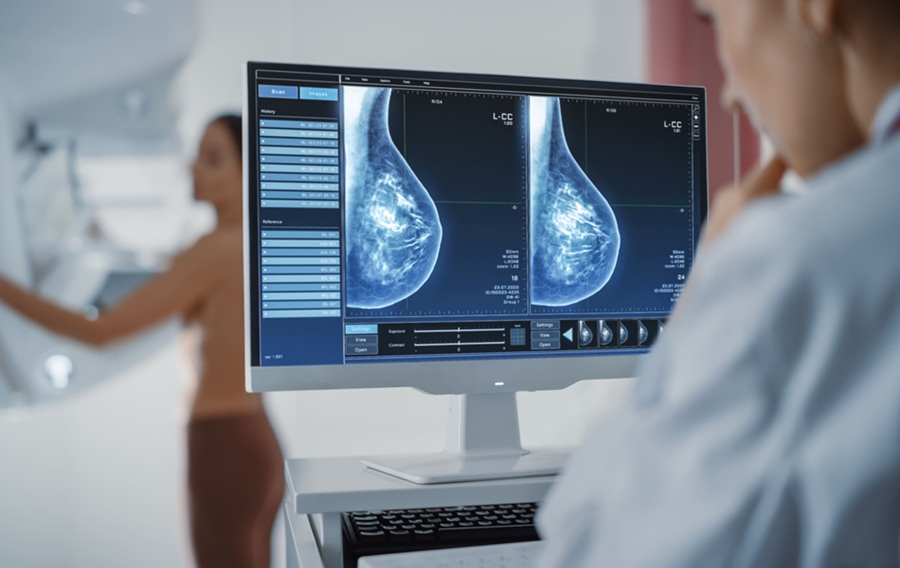Wireless Ultrasound Probe Increases Imaging Accessibility
|
By MedImaging International staff writers Posted on 19 Nov 2020 |

Image: The Vave handheld ultrasound scanner (Photo courtesy of Vave Health)
A new platform-as-a-service imaging sharing model makes ultrasound scans more accessible to healthcare providers, doctors, and patients.
The Vave Health (Santa Clara, CA, USA) handheld ultrasound device is a cordless probe with various scanning modes that allows users to practice untethered scanning and view clinical images on a smartphone via a proprietary mobile application. To address the prohibitive cost of medical imaging, various subscription plans are available; all include the Vave wireless probe, a battery, charger, a warranty, and a complimentary upgrade to the latest probe every 24 months. Subscriptions are priced at USD 99 per month.
The scanned ultrasound images can be cast to multiple devices, saved to Health Insurance Portability and Accountability Act (HIPAA) compliant secure cloud servers for review and storage, or emailed to colleagues for consultation. Vave subscribers also have on-demand access to education and advice from clinician partners via the Vave Assist service, which provides on-demand personalized feedback and image guidance whenever needed. Members are entitled to up to 10 images reviewed per month by a panel of ultrasound experts.
“With our ultrasound platform-as-a-service model, we're able to offer users uncompromised quality at an accessible price point. We can now provide partners with a platform that evolves with them,” said Amin Nikoozadeh, CEO and founder of Vave Health. “Clinicians, health systems, and medical students can now equip themselves to provide enhanced medical care no matter where they are through a unique and all-inclusive service, which provides a wireless probe, access to mentors and free upgrades every 24 months.”
The exponential growth of bedside ultrasound use in the intensive care unit (ICU) and hospital clinical wards has been driven by mounting clinical evidence showing heightened patient safety and less risk of complication when key interventions are performed with ultrasound guidance at the point of care, such as imaging the abdomen, heart, and lungs and guiding interventional procedures, such as nerve blocks and targeted injections.
Related Links:
Vave Health
The Vave Health (Santa Clara, CA, USA) handheld ultrasound device is a cordless probe with various scanning modes that allows users to practice untethered scanning and view clinical images on a smartphone via a proprietary mobile application. To address the prohibitive cost of medical imaging, various subscription plans are available; all include the Vave wireless probe, a battery, charger, a warranty, and a complimentary upgrade to the latest probe every 24 months. Subscriptions are priced at USD 99 per month.
The scanned ultrasound images can be cast to multiple devices, saved to Health Insurance Portability and Accountability Act (HIPAA) compliant secure cloud servers for review and storage, or emailed to colleagues for consultation. Vave subscribers also have on-demand access to education and advice from clinician partners via the Vave Assist service, which provides on-demand personalized feedback and image guidance whenever needed. Members are entitled to up to 10 images reviewed per month by a panel of ultrasound experts.
“With our ultrasound platform-as-a-service model, we're able to offer users uncompromised quality at an accessible price point. We can now provide partners with a platform that evolves with them,” said Amin Nikoozadeh, CEO and founder of Vave Health. “Clinicians, health systems, and medical students can now equip themselves to provide enhanced medical care no matter where they are through a unique and all-inclusive service, which provides a wireless probe, access to mentors and free upgrades every 24 months.”
The exponential growth of bedside ultrasound use in the intensive care unit (ICU) and hospital clinical wards has been driven by mounting clinical evidence showing heightened patient safety and less risk of complication when key interventions are performed with ultrasound guidance at the point of care, such as imaging the abdomen, heart, and lungs and guiding interventional procedures, such as nerve blocks and targeted injections.
Related Links:
Vave Health
Latest Ultrasound News
- Wearable Ultrasound Imaging System to Enable Real-Time Disease Monitoring
- Ultrasound Technique Visualizes Deep Blood Vessels in 3D Without Contrast Agents
- Ultrasound Probe Images Entire Organ in 4D

- Disposable Ultrasound Patch Performs Better Than Existing Devices
- Non-Invasive Ultrasound-Based Tool Accurately Detects Infant Meningitis
- Breakthrough Deep Learning Model Enhances Handheld 3D Medical Imaging
- Pain-Free Breast Imaging System Performs One Minute Cancer Scan
- Wireless Chronic Pain Management Device to Reduce Need for Painkillers and Surgery
- New Medical Ultrasound Imaging Technique Enables ICU Bedside Monitoring
- New Incision-Free Technique Halts Growth of Debilitating Brain Lesions
- AI-Powered Lung Ultrasound Outperforms Human Experts in Tuberculosis Diagnosis
- AI Identifies Heart Valve Disease from Common Imaging Test
- Novel Imaging Method Enables Early Diagnosis and Treatment Monitoring of Type 2 Diabetes
- Ultrasound-Based Microscopy Technique to Help Diagnose Small Vessel Diseases
- Smart Ultrasound-Activated Immune Cells Destroy Cancer Cells for Extended Periods
- Tiny Magnetic Robot Takes 3D Scans from Deep Within Body
Channels
Radiography
view channel
AI Detects Early Signs of Aging from Chest X-Rays
Chronological age does not always reflect how fast the body is truly aging, and current biological age tests often rely on DNA-based markers that may miss early organ-level decline. Detecting subtle, age-related... Read more
X-Ray Breakthrough Captures Three Image-Contrast Types in Single Shot
Detecting early-stage cancer or subtle changes deep inside tissues has long challenged conventional X-ray systems, which rely only on how structures absorb radiation. This limitation keeps many microstructural... Read moreMRI
view channel
Novel Imaging Approach to Improve Treatment for Spinal Cord Injuries
Vascular dysfunction in the spinal cord contributes to multiple neurological conditions, including traumatic injuries and degenerative cervical myelopathy, where reduced blood flow can lead to progressive... Read more
AI-Assisted Model Enhances MRI Heart Scans
A cardiac MRI can reveal critical information about the heart’s function and any abnormalities, but traditional scans take 30 to 90 minutes and often suffer from poor image quality due to patient movement.... Read more
AI Model Outperforms Doctors at Identifying Patients Most At-Risk of Cardiac Arrest
Hypertrophic cardiomyopathy is one of the most common inherited heart conditions and a leading cause of sudden cardiac death in young individuals and athletes. While many patients live normal lives, some... Read moreNuclear Medicine
view channel
PET Imaging of Inflammation Predicts Recovery and Guides Therapy After Heart Attack
Acute myocardial infarction can trigger lasting heart damage, yet clinicians still lack reliable tools to identify which patients will regain function and which may develop heart failure.... Read more
Radiotheranostic Approach Detects, Kills and Reprograms Aggressive Cancers
Aggressive cancers such as osteosarcoma and glioblastoma often resist standard therapies, thrive in hostile tumor environments, and recur despite surgery, radiation, or chemotherapy. These tumors also... Read more
New Imaging Solution Improves Survival for Patients with Recurring Prostate Cancer
Detecting recurrent prostate cancer remains one of the most difficult challenges in oncology, as standard imaging methods such as bone scans and CT scans often fail to accurately locate small or early-stage tumors.... Read moreGeneral/Advanced Imaging
view channel
AI-Based Tool Accelerates Detection of Kidney Cancer
Diagnosing kidney cancer depends on computed tomography scans, often using contrast agents to reveal abnormalities in kidney structure. Tumors are not always searched for deliberately, as many scans are... Read more
New Algorithm Dramatically Speeds Up Stroke Detection Scans
When patients arrive at emergency rooms with stroke symptoms, clinicians must rapidly determine whether the cause is a blood clot or a brain bleed, as treatment decisions depend on this distinction.... Read moreImaging IT
view channel
New Google Cloud Medical Imaging Suite Makes Imaging Healthcare Data More Accessible
Medical imaging is a critical tool used to diagnose patients, and there are billions of medical images scanned globally each year. Imaging data accounts for about 90% of all healthcare data1 and, until... Read more
Global AI in Medical Diagnostics Market to Be Driven by Demand for Image Recognition in Radiology
The global artificial intelligence (AI) in medical diagnostics market is expanding with early disease detection being one of its key applications and image recognition becoming a compelling consumer proposition... Read moreIndustry News
view channel
GE HealthCare and NVIDIA Collaboration to Reimagine Diagnostic Imaging
GE HealthCare (Chicago, IL, USA) has entered into a collaboration with NVIDIA (Santa Clara, CA, USA), expanding the existing relationship between the two companies to focus on pioneering innovation in... Read more
Patient-Specific 3D-Printed Phantoms Transform CT Imaging
New research has highlighted how anatomically precise, patient-specific 3D-printed phantoms are proving to be scalable, cost-effective, and efficient tools in the development of new CT scan algorithms... Read more
Siemens and Sectra Collaborate on Enhancing Radiology Workflows
Siemens Healthineers (Forchheim, Germany) and Sectra (Linköping, Sweden) have entered into a collaboration aimed at enhancing radiologists' diagnostic capabilities and, in turn, improving patient care... Read more



















